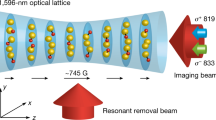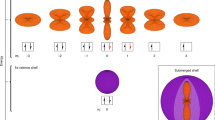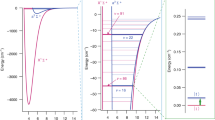Abstract
It has been roughly three decades since laser cooling techniques produced ultracold atoms1,2,3, leading to rapid advances in a wide array of fields. Laser cooling has not yet been extended to molecules because of their complex internal structure. However, this complexity makes molecules potentially useful for a wide range of applications4. For example, heteronuclear molecules possess permanent electric dipole moments that lead to long-range, tunable, anisotropic dipole–dipole interactions. The combination of the dipole–dipole interaction and the precise control over molecular degrees of freedom possible at ultracold temperatures makes ultracold molecules attractive candidates for use in quantum simulations of condensed-matter systems5 and in quantum computation6. Also, ultracold molecules could provide unique opportunities for studying chemical dynamics7,8 and for tests of fundamental symmetries9,10,11. Here we experimentally demonstrate laser cooling of the polar molecule strontium monofluoride (SrF). Using an optical cycling scheme requiring only three lasers12, we have observed both Sisyphus and Doppler cooling forces that reduce the transverse temperature of a SrF molecular beam substantially, to a few millikelvin or less. At present, the only technique for producing ultracold molecules is to bind together ultracold alkali atoms through Feshbach resonance13 or photoassociation14. However, proposed applications for ultracold molecules require a variety of molecular energy-level structures (for example unpaired electronic spin5,9,11,15, Omega doublets16 and so on). Our method provides an alternative route to ultracold molecules. In particular, it bridges the gap between ultracold (submillikelvin) temperatures and the ∼1-K temperatures attainable with directly cooled molecules (for example with cryogenic buffer-gas cooling17 or decelerated supersonic beams18). Ultimately, our technique should allow the production of large samples of molecules at ultracold temperatures for species that are chemically distinct from bialkalis.
This is a preview of subscription content, access via your institution
Access options
Subscribe to this journal
Receive 51 print issues and online access
$199.00 per year
only $3.90 per issue
Buy this article
- Purchase on Springer Link
- Instant access to full article PDF
Prices may be subject to local taxes which are calculated during checkout



Similar content being viewed by others
References
Chu, S. The manipulation of neutral particles. Rev. Mod. Phys. 70, 685–706 (1998)
Cohen-Tannoudji, C. N. Manipulating atoms with photons. Rev. Mod. Phys. 70, 707–719 (1998)
Phillips, W. D. Laser cooling and trapping of neutral atoms. Rev. Mod. Phys. 70, 721–741 (1998)
Carr, L., DeMille, D., Krems, R. & Ye, J. Cold and ultracold molecules: science, technology and applications. N. J. Phys. 11, 055049 (2009)
Pupillo, G. Micheli, A., Büchler, H.-P. & Zoller, P. in Cold Molecules: Theory, Experiment, Applications (eds Krems, R., Friedrich, B. & Stwalley, W. C.) Ch. 12 (CRC Press, 2009)
DeMille, D. Quantum computation with trapped polar molecules. Phys. Rev. Lett. 88, 067901 (2002)
Balakrishnan, N. & Dalgarno, A. Chemistry at ultracold temperatures. Chem. Phys. Lett. 341, 652–656 (2001)
Krems, R. V. Cold controlled chemistry. Phys. Chem. Chem. Phys. 10, 4079–4092 (2008)
Tarbutt, M., Hudson, J., Sauer, B. & Hinds, E. Prospects for measuring the electric dipole moment of the electron using electrically trapped polar molecules. Faraday Discuss. 142, 37–56 (2009)
Flambaum, V. V. & Kozlov, M. G. Enhanced sensitivity to the time variation of the fine-structure constant and m p /m e in diatomic molecules. Phys. Rev. Lett. 99, 150801 (2007)
DeMille, D., Cahn, S. B., Murphree, D., Rahmlow, D. A. & Kozlov, M. G. Using molecules to measure nuclear spin-dependent parity violation. Phys. Rev. Lett. 100, 023003 (2008)
Shuman, E. S., Barry, J. F., Glenn, D. R. & DeMille, D. Radiative force from optical cycling on a diatomic molecule. Phys. Rev. Lett. 103, 223001 (2009)
Ni, K.-K. et al. A high phase-space-density gas of polar molecules. Science 322, 231–235 (2008)
Sage, J. M., Sainis, S., Bergeman, T. & DeMille, D. Optical production of ultracold polar molecules. Phys. Rev. Lett. 94, 203001 (2005)
André, A. et al. A coherent all-electrical interface between polar molecules and mesoscopic superconducting resonators. Nature Phys. 2, 636–642 (2006)
Vutha, A. C. et al. Search for the electric dipole moment of the electron with thorium monoxide. J. Phys. At. Mol. Opt. Phys. 43, 074007 (2010)
Weinstein, J. D., deCarvalho, R., Guillet, T., Friedrich, B. & Doyle, J. M. Magnetic trapping of calcium monohydride molecules at millikelvin temperatures. Nature 395, 148–150 (1998)
Bethlem, H. L. et al. Electrostatic trapping of ammonia molecules. Nature 406, 491–494 (2000)
Maxwell, S. E. et al. High-flux beam source for cold, slow atoms or molecules. Phys. Rev. Lett. 95, 173201 (2005)
Patterson, D. & Doyle, J. M. Bright, guided molecular beam with hydrodynamic enhancement. J. Chem. Phys. 126, 154307 (2007)
Allouche, A. R., Wannous, G. & Aubért-Frecon, M. A ligand-field approach for the low-lying states of Ca, Sr and Ba monohalides. Chem. Phys. 170, 11–22 (1993)
Dagdigian, P. J., Cruse, H. W. & Zare, R. N. Radiative lifetimes of the alkaline earth monohalides. J. Chem. Phys. 60, 2330–2339 (1974)
Di Rosa, M. D. Laser-cooling molecules. Eur. Phys. J. D 31, 395–402 (2004)
Stuhl, B. K., Sawyer, B. C., Wang, D. & Ye, J. A magneto-optical trap for polar molecules. Phys. Rev. Lett. 101, 243002 (2008)
Berkeland, D. J. & Boshier, M. G. Destabilization of dark states and optical spectroscopy in Zeeman-degenerate atomic systems. Phys. Rev. A 65, 033413 (2002)
Emile, O. et al. Magnetically assisted Sisyphus effect. J. Phys. II Fr. 3, 1709–1733 (1993)
Gupta, R., Padua, S., Xie, C., Batelaan, H. & Metcalf, H. Simplest atomic system for sub-Doppler laser cooling. J. Opt. Soc. Am. B 11, 537–541 (1994)
Plimmer, M. D. et al. 2D laser collimation of a cold Cs beam induced by a transverse B field. JETP Lett. 82, 17–21 (2005)
Childs, W. J., Goodman, L. S. & Renhorn, I. Radio-frequency optical double-resonance spectrum of SrF: the X2Σ+ state. J. Mol. Spectrosc. 87, 522–533 (1981)
Kändler, J., Martell, T. & Ernst, W. Electric dipole moments and hyperfine structure of SrF A2Π and B2Σ+ . Chem. Phys. Lett. 155, 470–474 (1989)
Acknowledgements
This material is based upon work supported by the ARO, the NSF and the AFOSR under the MURI award FA9550-09-1-0588.
Author information
Authors and Affiliations
Contributions
The experimental work, data analysis and theoretical calculations were performed by E.S.S., J.F.B. and D.D.
Corresponding author
Ethics declarations
Competing interests
The authors declare no competing financial interests.
Supplementary information
Supplementary Information
This file contains Supplementary Information comprising Experimental set-up, Capture velocity and optimum magnetic field for Sisyphus and Doppler forces, Estimation of temperature and power of Sisyphus and Doppler cooling. Also included are Supplementary Figures 1-4 with legends. (PDF 249 kb)
Rights and permissions
About this article
Cite this article
Shuman, E., Barry, J. & DeMille, D. Laser cooling of a diatomic molecule. Nature 467, 820–823 (2010). https://doi.org/10.1038/nature09443
Received:
Accepted:
Published:
Issue Date:
DOI: https://doi.org/10.1038/nature09443
This article is cited by
-
Theoretical electronic structure with spin–orbit coupling effect of the molecules SrAt and BaAt for laser cooling studies
Scientific Reports (2024)
-
Precision spectroscopy and laser-cooling scheme of a radium-containing molecule
Nature Physics (2024)
-
A Feshbach resonance in collisions between triplet ground-state molecules
Nature (2023)
-
Many-body chemical reactions in a quantum degenerate gas
Nature Physics (2023)
-
Relativistic coupled-cluster study of SrF for low-energy precision tests of fundamental physics
Theoretical Chemistry Accounts (2023)
Comments
By submitting a comment you agree to abide by our Terms and Community Guidelines. If you find something abusive or that does not comply with our terms or guidelines please flag it as inappropriate.



